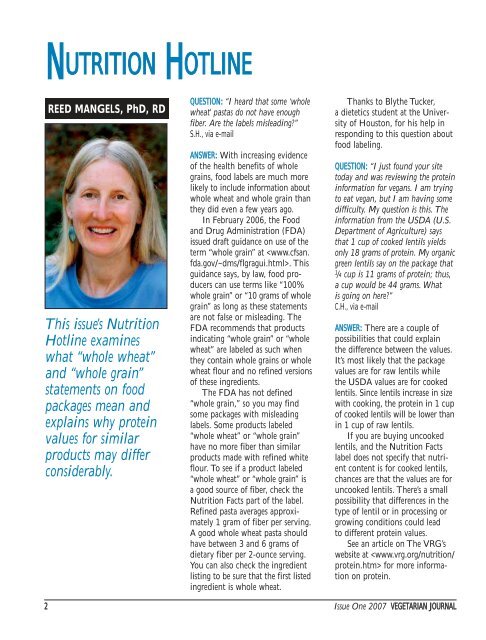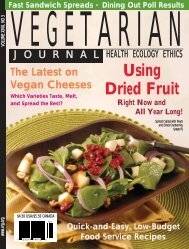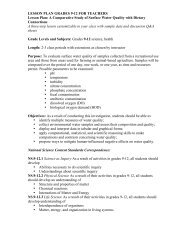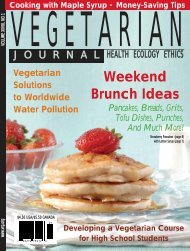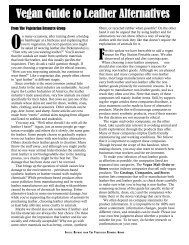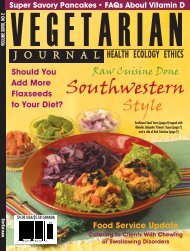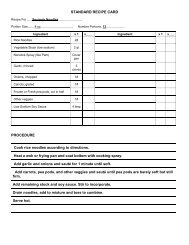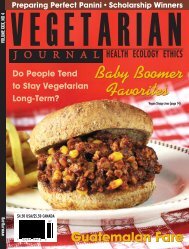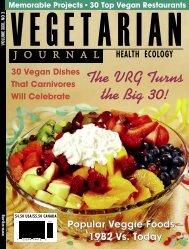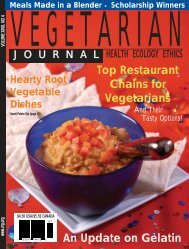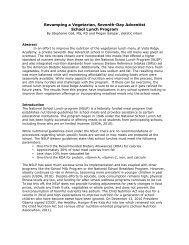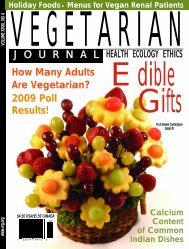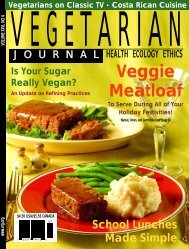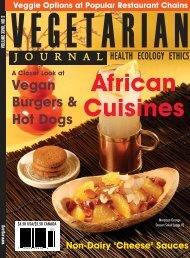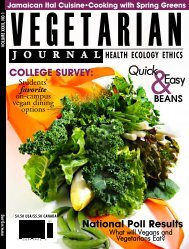Vegan Thickeners - The Vegetarian Resource Group
Vegan Thickeners - The Vegetarian Resource Group
Vegan Thickeners - The Vegetarian Resource Group
You also want an ePaper? Increase the reach of your titles
YUMPU automatically turns print PDFs into web optimized ePapers that Google loves.
NUTRITION HOTLINE<br />
REED MANGELS, PhD, RD<br />
This issue’s Nutrition<br />
Hotline examines<br />
what “whole wheat”<br />
and “whole grain”<br />
statements on food<br />
packages mean and<br />
explains why protein<br />
values for similar<br />
products may differ<br />
considerably.<br />
QUESTION: “I heard that some ‘whole<br />
wheat’ pastas do not have enough<br />
fiber. Are the labels misleading?”<br />
S.H., via e-mail<br />
ANSWER: With increasing evidence<br />
of the health benefits of whole<br />
grains, food labels are much more<br />
likely to include information about<br />
whole wheat and whole grain than<br />
they did even a few years ago.<br />
In February 2006, the Food<br />
and Drug Administration (FDA)<br />
issued draft guidance on use of the<br />
term “whole grain” at . This<br />
guidance says, by law, food producers<br />
can use terms like “100%<br />
whole grain” or “10 grams of whole<br />
grain” as long as these statements<br />
are not false or misleading. <strong>The</strong><br />
FDA recommends that products<br />
indicating “whole grain” or “whole<br />
wheat” are labeled as such when<br />
they contain whole grains or whole<br />
wheat flour and no refined versions<br />
of these ingredients.<br />
<strong>The</strong> FDA has not defined<br />
“whole grain,” so you may find<br />
some packages with misleading<br />
labels. Some products labeled<br />
“whole wheat” or “whole grain”<br />
have no more fiber than similar<br />
products made with refined white<br />
flour. To see if a product labeled<br />
“whole wheat” or “whole grain” is<br />
a good source of fiber, check the<br />
Nutrition Facts part of the label.<br />
Refined pasta averages approximately<br />
1 gram of fiber per serving.<br />
A good whole wheat pasta should<br />
have between 3 and 6 grams of<br />
dietary fiber per 2-ounce serving.<br />
You can also check the ingredient<br />
listing to be sure that the first listed<br />
ingredient is whole wheat.<br />
Thanks to Blythe Tucker,<br />
a dietetics student at the University<br />
of Houston, for his help in<br />
responding to this question about<br />
food labeling.<br />
QUESTION: “I just found your site<br />
today and was reviewing the protein<br />
information for vegans. I am trying<br />
to eat vegan, but I am having some<br />
difficulty. My question is this. <strong>The</strong><br />
information from the USDA (U.S.<br />
Department of Agriculture) says<br />
that 1 cup of cooked lentils yields<br />
only 18 grams of protein. My organic<br />
green lentils say on the package that<br />
1<br />
/4 cup is 11 grams of protein; thus,<br />
a cup would be 44 grams. What<br />
is going on here?”<br />
C.H., via e-mail<br />
ANSWER: <strong>The</strong>re are a couple of<br />
possibilities that could explain<br />
the difference between the values.<br />
It’s most likely that the package<br />
values are for raw lentils while<br />
the USDA values are for cooked<br />
lentils. Since lentils increase in size<br />
with cooking, the protein in 1 cup<br />
of cooked lentils will be lower than<br />
in 1 cup of raw lentils.<br />
If you are buying uncooked<br />
lentils, and the Nutrition Facts<br />
label does not specify that nutrient<br />
content is for cooked lentils,<br />
chances are that the values are for<br />
uncooked lentils. <strong>The</strong>re’s a small<br />
possibility that differences in the<br />
type of lentil or in processing or<br />
growing conditions could lead<br />
to different protein values.<br />
See an article on <strong>The</strong> VRG’s<br />
website at for more information<br />
on protein.<br />
2 Issue One 2007 VEGETARIAN JOURNAL


